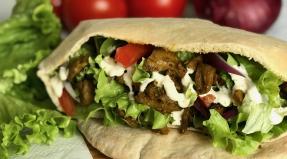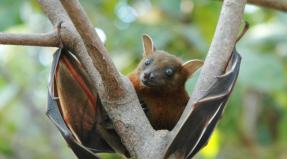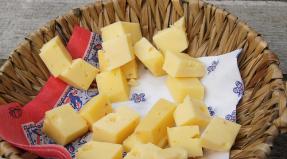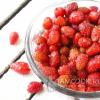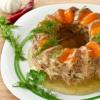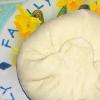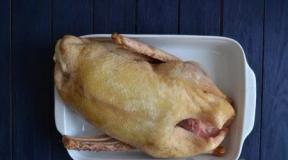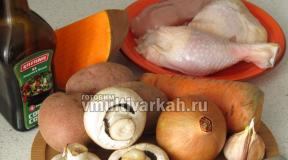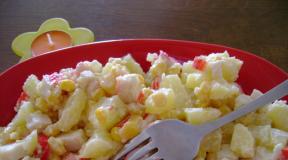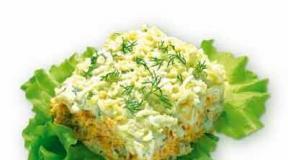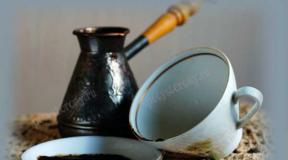The national drink is koumiss. Tea, koumiss, ayran: national drinks and their correct recipe
Gastronomic tourism in Kazakhstan "Cooking Kazakh drink - koumiss".
“And then the day came when koumiss jumped,
It is not for nothing that the mistress of the generous baibishe is known,
But Baibishe hesitates: she doesn’t count on hurrying.
Saken Saifullin. 1910 - 1913 "Kumiss on jail". Translation by A. Kafanov.
Tours across Kazakhstan from Astana.
The favorite drink of the Kazakhs has always been koumiss, which was also used for medicinal purposes. To prepare it, mare's milk is poured into a leather vessel - saba and ferment it, after which they let it stand for a day or two, often shaking at this time with a special whorl - Pispec. The mares were milked five or six times a day. Kumys (kymyz) fermented milk drink made from fresh mare's milk.
Among the people, it has been known since ancient times. The shelf life of koumiss is no more than 3 days. For the future, a sourdough is prepared - kor: mature koumiss is left in a vessel for several days so that it is divided into 2 layers - the upper liquid, transparent and the lower thick, curdled. The top layer is drained, the bottom is filtered through gauze and dried in the sun.
Dry sourdough - the core is placed in a vessel and, closed with a lid, stored in a cool place until the next season. Prepared in 2 ways: industrial and folk. At the enterprises of the dairy industry, milk is fermented with pure cultures of Bulgarian bacillus and yeast, kneading for 20 minutes. The acidity of the sourdough is 50 - 60 "according to Turner.
A mixture of milk and sourdough is left for 1.0 - 1.5 hours to mature. Then knead again for 1 hour. For 15 - 20 min. until ready, koumiss is cooled to 17 "C, bottled, corked, put in a refrigerator with a temperature of 0 to 4" C.
The shelf life of koumiss is no more than 3 days. Depending on the alcohol content and acidity, koumiss is classified as weak, medium and strong. Koumiss is a homogeneous, stinging, foaming, white liquid with a specific sour-milk (slightly yeasty) taste, creamy taste; acidity 81 - 100 "T; density 1.020 - 1.018; contains up to 1.5% ethanol, outlet temperature 6" C.
In Kazakhstan, the folk way of making koumiss is more popular. For the future, a sourdough is prepared - kor: mature koumiss is left in a vessel for several days so that it is divided into 2 layers - the upper liquid, transparent and the lower thick, curdled.
The top layer is drained, the bottom is filtered through gauze and dried in the sun. Dry sourdough - the core is placed in a vessel and, closed with a lid, stored in a cool place until the next season. Before use, the bark is ground into powder, poured into fresh mare's milk at the rate of 3-4 tablespoons per 5 liters of milk, mixed.
The mixture is left for a day in a warm place, stirring occasionally. The finished sourdough is used only once to obtain the 1st batch of koumiss: in the subsequent sourdough, new mature koumiss serves.
Sabu is made - a bag of skin of an adult well-fed horse with a capacity of 100 - 150 liters; the skin, having previously shaved off the wool from it, is kept in a strong solution of table salt, pulled out and smoked in the smoke of meadowsweet or birch, and a bag is sewn from it. The finished sub is only used for 1 season. To prepare koumiss, 1/4 - 1/2 of its volume is poured with fresh milk with sourdough and left overnight.
In the morning of the next day, add a portion of fresh milk to it, mix thoroughly. Having endured 10 - 15 hours, fresh milk is again added to the full volume of the saba, thoroughly kneaded. After a day, koumiss is ready for use. The more often knead, the tastier koumiss. Once in 10 - 15 days, the saba is freed from koumiss, washed thoroughly with water, dried, rinsed with cow's milk and smoked.
The sub is ready to use again. Hundreds of tons of koumiss are harvested annually in the republic. Kumis is used to treat lung and gastrointestinal diseases. In the coming years, 15 complexes for the production of koumiss will be built in the republic. Koumiss and fresh mare's milk, unlike cow's milk, are rich in sugar and vitamin C.
At present, there is a tendency to increase the production of koumiss with a decrease in livestock, which can be explained by the peculiarities of small-scale production. There are many legends about its healing properties. Even the great Russian writers Leo Tolstoy and Anton Chekhov went to Kalmykia "to drink koumiss". In London, a liter of koumiss costs a few dollars.
In Germany, mare's milk is used in the perfumery and cosmetics industry.
Today in Kazakhstan (September 2001) there are 200,000 working horses. Kumis is used for medicinal purposes, the medicinal and nutritional value of this drink is due to the content of easily digestible proteins (albumins), vitamins and minerals, ethyl alcohol, antibiotics produced by sourdough microorganisms, the balance of amino acids, and the specific composition of fat.
Kumis has long been used in Kazakhstan for medicinal purposes, for malnutrition, anemia, scurvy, rickets, digestive disorders, neurasthenia, and also for pulmonary tuberculosis. The first koumiss sanatorium was opened in 1856 in Samara. Kymys enhances peristalsis of the gastrointestinal tract, sap secretion, blood formation, activates gastric juice, stimulates bile formation and bile secretion, inhibits the growth of pathogenic microbes in the intestine.
Kumis on the zhailau.
And then the day came when koumiss jumped,
When young and old crowded together in a bay yurt,
With a cheerful ringing in wineskins, a drink boils,
Bai called all the farm laborers today.
It is not for nothing that the mistress of the generous baibishe is known,
She will pour koumiss into large bowls,
And the fragrance of the steppes will spread around,
But Baibishe hesitates: she does not count on hurrying.
0 god! On bowls such a pattern is colored,
What a poor man is afraid to touch with his hand!
And the baibishe is good: know he treats plenty,
And no one wants to go home.
They took off all their shoes and, full of joy,
They sit as if they were invited to rest.
But the bai starts talking about the case -
Like, it's time to bring out herds for grazing.
Forget, poor people, about this full day,
For everything tomorrow you will be asked doubly.
Kumis is the national drink of the Turkic peoples. It is a kind of sour mare's milk with a transparent whitish color.
Kumis is the oldest product of the equestrian nomadic civilization of the Great Steppe - the steppe zone of Eurasia, stretching from the Black Sea to the Pacific Ocean. Since ancient times, Kazakh traditional medicine has attributed this product to health-improving drinks, and also as a means of curing consumption-kyoksau (pulmonary tuberculosis). The fact is that the Western Steppe (part of the Great Steppe from Altai to the west) is the natural focus of this dangerous disease of humans and farm animals. The domestication of livestock led to the spread of this disease in the human population and its spread throughout Eurasia, and then throughout the world. Even in our time, tuberculosis is the cause of more than half of the deaths from diseases, this is especially pronounced in backward countries.
European researchers of the 17th-18th centuries naively believed that the inhabitants of the Great Steppe did not suffer from tuberculosis, and, accordingly, were unaware of its therapeutic effect. But they did not suspect that the steppe civilization survived in the fight against tuberculosis - the eternal companion of equestrian nomads, only thanks to koumiss and other fermented milk products. There was a multi-thousand-year mutual adaptation of the tubercle bacillus and the steppe population, with their sour-milk culture, as a protective system of powerful microbial symbioses. Therefore, manifestations of this disease in an open form in the Steppe are quite rare. However, when tuberculous bacilli get to other countries, without meeting the usual opposition of a sour-milk culture, it becomes aggressive. Moreover, not only Europeans, but also immigrants from the Steppe, leaving for Europe, switch to the local food diet and often fall ill with tuberculosis in an open form. At the same time, the matter is not in the meager nutrition of visitors. So the son of the Khan of the Middle Zhuz Shokan Ualikhanov, living in St. Petersburg, could afford any excess diet, but he ate according to the European system, as a result he fell ill with consumption.
The disease spared neither the lower nor the aristocratic circles of Europe. And the ancient steppe knowledge about the only cure for tuberculosis at that time came to Europe approximately from the 17th century through travelers and researchers of the steppe culture on the one hand, and direct contacts of the population of European peoples with the Steppe on the other hand. For example, in the northern forest-steppe zone, Russian peasants at the end of the 17th century went to the Bashkir lands to be treated with koumiss for consumption (according to P.S. Pallas). And in the steppes of the Volga region, peasants came to recover from ailments, temporarily living in the wagons of the Kirghiz (Kazakhs) in order to purchase koumiss (memoirs of N.V. Postnikov). The middle of the 19th century in Europe is characterized by a powerful development of science and medicine. Therefore, it is not accidental that the world's first scientific anti-tuberculosis koumiss clinics were opened almost simultaneously in Russia in 1858 (N.V. Postnikov in Samara) and in Germany in 1859 (Bremer's sanatorium in Gebersdorf).
Koumiss sanatorium
The wildest and most ancient resorts, in fact, were the seasonal migrations of the steppes to the dzhailau. During this period, the Kazakhs could switch to food only with koumiss, and this, in fact, is an absolute “koumiss diet”, by the way, extremely healthy. At the same time, they could drink from 15 to 18 liters of koumiss per day. However, the very first, European-organized, koumiss resort, or "sanatorium" in the Kazakh steppe was a wooden palace in the summer headquarters of Khan Zhangir, built in 1841. Before him, stationary buildings for the summer headquarters of the steppe rulers had never been made. Dzhangir built a luxurious for those times, specially designed pavilion, similar to the same building built in his winter quarters. Zhangir dedicated both buildings to his beloved second wife, the beautiful Fatima, the daughter of a Tatar mufti. Since she had never lived in a yurt, the khan noticed that she felt uncomfortable there. Khan, being a reformer by nature, began by reorganizing his dwelling in a new style.
Definitely, Khan Zhangir tried to do everything according to the European model, according to the type of early European palace and park ensembles. Even his office in the winter headquarters resembles the office of Peter I in Monplaisir, made in the Dutch style. Accordingly, places for stakes were chosen very carefully, taking into account the creation of forest park zones. So, Russian geologists were invited to choose the place of the winter rate, to find areas with groundwater closest to the surface. In the area of the summer rate, plantings were carried out in the natural lowlands of the floodplain of the Torgun River, these areas were flooded during floods. Moreover, Pritorgunye, due to the peculiarities of the relief, is the birthplace of estuary irrigation. Simultaneously with the construction of the summer palace headquarters in 1841, the first two dams of the estuary system Savinskaya and Khanskaya were erected on the territory of the Bukey Horde. The latter served to irrigate the territory of the Khan's Summer Palace. For landscaping, Khan Zhangir ordered seeds and seedlings of oak, birch and elm from the Orenburg governor.
In both rates, depending on the season, the khan received guests, served them with koumiss, and treated people who were unaccustomed to such a drink even with champagne. Foreign guests, as well as aristocratic and imperial persons from Russia, were incredibly surprised at this. For example, the well-known Russian writer S.T. Aksakov visited Zhangir Khan and gave a flattering assessment of the Khan's personality, and also mentioned treats with koumiss and champagne at his headquarters.
For some time Fatima was ill, and Zhangir took her to mineral waters for treatment, and also treated her with koumiss at his summer headquarters.
Some preserved Kazakh legends about this are curious. For example, about the presence of a "sugar lake" near the palace of Khan Zhangir, into which sugar was poured to attract swans. Apparently, this is Lake Kolborsy near the summer headquarters, on the shore of which, as a bait for swans, crushed sugar "nahuat" could indeed be poured. There was also a legend about how Zhangir Khan cured his beloved wife with koumiss, which is confirmed by the factual material about her illness and treatment. The origin of the modern koumiss clinic created on the site of the summer camp is legend associated with the production of koumiss under Khan Zhangir. This is also evidenced by the popular name of the existing sanatorium: Kumys-Orda - literally, "koumiss (khan's) rate."
Thus, according to all the criteria: the presence of a forest park zone, a lake with a beautiful view, a convenient pavilion for housing, the presence of koumiss production at the site, the presence of guests who come to rest or be treated - Zhangir Khan's summer headquarters fits the definition of a koumiss sanatorium.
Therefore, it can be said with certainty that in fact of its existence, the summer khan's headquarters Kumys-Orda, being a private resort of Khan Zhangir, and created in 1841, turned out to be not only the first Kazakh koumiss resort, but in general the first koumiss sanatorium in the world. Moreover, later it grew into the first pre-revolutionary Kazakh koumiss clinic of Shangerey Bokeev, the grandson of Zhangir Khan. And after the revolution, it became one of the first Soviet koumiss clinics, organized by Kildibekov Akhmetgali, who was a koumiss master in both last clinics.
Nurlan Kildibekov
Doctor of Biological Sciences, biochemist, currently lives in Canada, Edmonton
For copying and publishing materials, written or oral permission of the editorial office or the author is required. A hyperlink to the Qazaqstan tarihy portal is required. All rights reserved by the Law of the Republic of Kazakhstan "On Copyright and Related Rights" .. - 111)
11.06.2015
Kumis is a legendary drink of the Turkic peoples, made from the milk of mares. As soon as they do not call this miraculous elixir - “pearl of the east”, “milky wine”, “drink from the paradise river”, which saved the steppe nomads from thirst and hunger, healed from diseases.
The first mention of koumiss dates back to the 5th century BC. The traveler Herodotus mentioned koumiss as a favorite drink of the Scythians, the recipe of which was hidden under fear of blinding. The Polovtsy did not disdain koumiss either, having let Prince Igor Seversky out of captivity in 1182, drunk from drinking.
Kumis - what is it?
It is a fermented milk product made from mare's milk, foamy, refreshing, sweet and sour, slightly intoxicating.
By the way, this is the only alcohol that is not prohibited for consumption by Muslims.
Depending on the fermentation time, young koumiss is distinguished (fermentation time is 5-6 hours, 1% alcohol), medium (1-2 days, 2% alcohol), strong (3-4 days, 4-5% alcohol). Kumis is the only drink obtained through 3 types of fermentation: lactic acid, alcohol and yeast.
Composition
There are plenty of useful vitamins in the chemical composition of this product. Speaking about the protein content, experts call the number 2-2.5%, based on the fat content of milk, the percentage of fat ranges from 1% to 2%, and sugar in koumiss is even higher - 3-4.5%. The vitamin composition is also full of variety, here is vitamin C (200 mg of vitamin C per 1 kg of koumiss), vitamin A and B, E and PP. Trace elements in koumiss are the following: calcium, magnesium and phosphorus. The list of “usefulnesses” of the product does not end there; lactic acid and biotin, as well as ethyl alcohol, will be useful for the human body. 
It is difficult to call koumiss a dietary product due to the presence of sugars and alcohol in it, but this does not make it less beneficial to human health. Today's traditional medicine widely uses koumiss for the prevention and treatment of a large list of diseases, in addition, such types of treatment as koumiss therapy and koumiss treatment have become relevant.
Useful properties of koumiss
The beneficial properties of koumiss are truly unique and allow the drink to be used in the treatment of serious diseases. Mare's milk, unique in its composition, contains more vitamins than cow's and goat's milk, essential fatty acids. And during the fermentation process, milk protein breaks down and turns into easily digestible forms, which helps to obtain a product with a nutrient digestibility of more than 95%. It is not for nothing that koumiss, whose beneficial properties allow you to quickly rehabilitate after illnesses, improve digestion, strengthen immunity, is called a heroic drink. 
Useful properties of such a drink as koumiss have been known to man since ancient times, since the beginning of the 19th century, healers and traditional healers began to use this miracle product to cure many chronic diseases. The most popular koumiss was for people with chronic tuberculosis, which receded during koumiss therapy.
According to most scientists and professors, the composition of mare's milk is almost identical to that of a woman's breast milk. Similarity is observed in such components of koumiss as sugar and protein, qualitative features of fats, a large vitamin composition, microelements and other substances. It is all these components of mare's and mother's milk of a woman that are the main keys to supporting human life in a normal state. 
In addition, the “magic” properties of koumiss lie in the fact that during the fermentation of milk, its useful components either retain their properties, or after protein hydrolysis, they become even more digestible for the human body. Due to this, koumiss is always distinguished by its mild and nutritious taste, appetizing aroma and is easily accepted by the gastrointestinal tract.
All the therapeutic properties of koumiss can be felt if you take it regularly and for a long time. The characteristic medicinal properties of koumiss are as follows:
- general strengthening effect;
- anti-inflammatory effect;
- healing actions;
- antibacterial effect;
- choleretic effect;
- antianemic effect;
- calming effect;
- probiotic influence.
Koumiss becomes an indispensable product if a person is exposed to infectious diseases, tuberculosis, complicated diseases of the intestines and stomach, and intestinal infections. After drinking the drink, the body receives general strengthening support to fight the disease and recover.
Contraindications of koumiss
In general, koumiss is considered a harmless food product, since all its components are easily absorbed by the human body without overloading metabolic processes. But still there are several categories of people for whom this product is contraindicated.
- Any diseases of the gastrointestinal tract in case of exacerbation.
- People who have an individual intolerance to one or more components that are part of koumiss.
Despite the fact that koumiss is considered an alcoholic drink, it is not considered harmful and is allowed to be consumed even in Muslim countries where prohibition is in force.
Making koumiss
Koumiss is made, the recipe of which was carried through the millennia by wise aksakals, in our time, both in families and on small koumiss farms and clinics, and on an industrial scale according to the same principle. The beginning of all beginnings is the milk of a mare, which is milked up to 6 times a day. Moreover, you need to be a skilled milker, because the milking time is limited to 18-20 seconds. Even proud dzhigits and famous riders milked mares, not considering it only as a female occupation. 
After milking, fresh milk is poured into a wooden tub (in ancient times, these were sheep skins rubbed with wood to remove unwanted bacteria and flavors) and kneaded with the addition of mature koumiss for several hours with a special wooden spoon at a temperature close to 20 degrees. Then it is bottled and left for fermentation, depending on what kind of koumiss is needed - young, medium or mature.
A bit of history
More than 30 types of koumiss were made by experienced craftsmen! They differ depending on the season, the time of the mare's foal (koumiss with the taste of colostrum is a special delicacy). A special delicacy for children and adolescents was koumiss with the addition of raisins, sugar, and honey. 
In the 19th century, Russian doctors opened the first koumiss clinic, where they healed patients with consumption and tuberculosis, since koumiss even contains antibiotics. In addition, what koumiss is useful for is the content of lactic acid bacteria that normalize digestion processes, improve the absorption of nutrients from other products, vitamins that strengthen immunity, improve hematopoiesis, restore the nervous system and potency and men. The longevity of the inhabitants of Asia is associated with the constant use of koumiss.
So the horse - the steppe nurse, which gave the nomads both food and drink, gave a wonderful gift - healing koumiss, which you can drink for several days even in the heat, and not feel tired, thirsty or hungry, and continue your long journey in search of the best pastures.
In general, the history of koumiss goes back several millennia, when koumiss was recognized as a miraculous drink. The first gourmets who appreciated the taste of the drink were the inhabitants of the nomadic tribes of Central Asia and the southeastern part of majestic Russia. The product immediately began to enjoy incredible demand, as it easily quenched not only thirst, but also hunger, was a nutritious and invigorating drink. After a while, the nomads noticed that with the help of koumiss, many people were healed of diseases and ailments. 
In ancient Greece, one of the popular historians, Herodotus, led a descriptive description of the customs and life of many peoples; he mentioned koumiss in the 5th century BC. e. According to him, the Scythian nomads could not imagine their life without koumiss. Speaking about Slavic history, the first facts about koumiss were found in the records of how in the 12th century Prince Seversky was able to escape from the Polovtsian captivity, when the guards got drunk on koumiss and lost all vigilance. Since then, this drink has become famous for its heady abilities.
Bashkirs, Kirghiz and Kazakhs, as well as Mongols, considered koumiss to be the national drink. And only after the popularity of koumiss, they began to replace it with cow and camel milk, in particular, the Kalmyks.
Koumiss treatment
For the treatment of many diseases with the help of koumiss, experts recommend starting from the level of acidity in the stomach.
Recipe number 1: low stomach acid
For treatment in this way, you need to stock up on 750 ml of koumiss. You need to drink a drink half an hour before a meal in the amount of 1 cup, three times a day. The course of treatment in this way lasts 1 month.
Recipe number 2: normal and increased acidity of the stomach
In this case, a person will need 750 ml of a drink, which in the amount of one glass should be drunk before each meal for 15 minutes, but not more often 3 times a day. The duration of the drink will be from 20 to 25 days, depending on how you feel.
Recipe number 3: after surgery to recover from normal and high acidity
Most often, this treatment is prescribed to people who have undergone surgery with a diagnosis of stomach ulcers. In the morning they drink 50 ml of koumiss, in the afternoon - 100 ml, and in the evening - 200 ml of fresh koumiss. At the same time, it should be consumed no earlier than an hour and a half before a meal. Treatment lasts from 20 to 25 days.
Recipe number 4: after surgery for recovery from low acidity
After surgery for stomach ulcers, koumiss is consumed 4 times a day, half an hour before meals. A single dose of the drink is 50 ml. Gradually, the dosage of a single dose is increased to 200 ml. The course of treatment is the same - 20-25 days.
Recipe number 5: the return of strength and body weight
For treatment, you will need 1.5 liters of the drink, which you need to gradually drink throughout the day. The duration of treatment is 20-25 days.
Miraculous drink koumiss
In order to understand how useful koumiss is for human health and whether it is worth using it regularly, you need to know what miraculous effects it suggests:
- It is used as a prophylaxis of seasonal ailments in the respiratory system.
- A drink that has a choleretic and mild laxative effect will help relieve spasms and bloating.
- Koumiss has an anti-inflammatory and regenerating effect after surgical interventions for the treatment of gastric and duodenal ulcers, it normalizes the functioning of the pancreas and promotes successful lactation.
- It is impossible not to note the beneficial effect of koumiss on the functioning of blood vessels and the heart.
- It normalizes the microflora of the intestines and vagina of a woman.
- Enriched with calcium, the drink strengthens the bone base and teeth.
Kumis is not only able to heal the human body, it also invigorates mental strength and energy, eliminates nervous tension and depression.
On the eve of the opening of the International Exhibition "EXPO-2017" we have a unique opportunity to present traditional food products to the world as exclusive ones.
What is the current state of our traditional food products and what measures are being taken in the country to raise their status and improve their quality? This is the topic of our conversation with the President of the Kazakh Academy of Nutrition, academician Toregeldy SHARMANOV.
- Toregeldy Sharmanovich, it is known that among the national foodstuffs of the Kazakh people the most popular at all times was koumiss - a healing drink made from mare's milk. For many centuries, interest in it has not decreased. What is his secret?
– Each nation has its own sacred symbols that determine the originality of their existence in the universe. The steppe and horses are symbols of the love of freedom of our nomadic ancestors, they passed them on to their descendants like a baton of freedom and independence. The historical value of horses for the nomadic tribes that inhabited the endless steppes is great. The horses were with them on the battlefields and shared with the owner all the hardships of military campaigns, served people faithfully. The extraordinary beauty and grace of horses are heartfeltly sung in folklore. The son of the steppes, Akan-sere, in his sad ode, a masterpiece of Kazakh oral literature, colorfully and touchingly describes the virtues of his faithful horse Kulager. The centuries-old history of the Kazakhs is closely connected with this noble animal, and at all times they were sacredly revered by the people.
Today, the descendants of yesterday's nomads are saddling more and more "iron horses", exploring space, building comfortable cities. And therefore it seems that in the soul of the people there is no longer that flight that was inherent in our ancestors. And the steppe, which once served as the cradle of the nomadic people, although it blooms in the spring, as before, seems to now look orphaned, involuntarily reflecting the state of mind of today's generation. In striving for civilization, as for the common good, peoples imperceptibly lose their identity. And against the backdrop of all-terrestrial progress, horses remain those rare living threads that connect us with the times of our ancestors.
Today we are talking about koumiss, the magic drink of nomads, made from mare's milk. Kumis, having stepped over the centuries, has not lost its divinity. This is a healing drink that has contributed to the formation of our gene pool. Its unique taste and intoxicating aroma seem to take us back into the mists of time, to the origins... For our ancestors, it was a kind of elixir of youth and health, relieving serious ailments. Truly, it represents the pinnacle of our folk medicine, giving strength to the weakened, health to the sick, mood to the saddened. Since ancient times, Kazakhs have known, appreciated and used the healing properties of koumiss in the treatment of tuberculosis, a disease that has not yet lost its mortal danger to humanity.
In Soviet times, many useful national traditional products were left out of the production process. In contrast to them, the store shelves were overflowing with other, no less "attractive" drinks, which brought enormous benefits to the general treasury, but at the same time caused irreparable damage to our traditional culture and temper.
– I grew up in the village and I remember how my parents kept horses, and my mother cooked koumiss from mare's milk, which the whole family and the guests who came to drink...
– Quite right! Despite all the obstacles, in many private farmsteads, the villagers milked mares and thus continued the traditional craft of making koumiss. Today, private entrepreneurs in their peasant farms contribute to its preservation.
They sell their products in small and large city markets, thus solving the problem of supplying patients with a healing drink. It is clear that so far there can be no talk of a mandatory offer of koumiss in sanatoriums or hospitals, although some private institutions are trying to resolve this issue on their own. And the problem of satisfying the general demand is still open, especially since the price of the issue hits the pockets of many, so koumiss for most people, unfortunately, remains a truly divine drink.
– What kind of koumiss that you have tried today can you call a kind of standard of quality?
– Among private entrepreneurs, I want to name the one whose koumiss I tried myself and whose quality I liked. We are talking about the farm "Sarsebek", located near Talgar. It is headed by a private entrepreneur Kerimbek Tleubaev - one of the enthusiasts of this difficult business, he does everything to develop and popularize the drink and horse breeding in general. This is a very necessary and useful thing, and it needs state support.
In the current age of intense globalization, the need to preserve folk traditions and crafts is becoming more and more acute, which, without proper measures, can disappear without a trace in the turbulent stream of modernity. Therefore, the time has come to take our traditional products under state control, to protect them as an industry that especially needs state subsidies. Mandatory state support is needed for peasant farms, which, despite the fact that they are in free floating, are trying to somehow continue the work of their ancestors and provide our dastarkhan with useful traditional food products.
- I think that readers will be interested to know your authoritative opinion as a scientist about the beneficial properties of mare's milk and koumiss.
- Mare's milk is still not appreciated for its beneficial properties. It contains many rare chemical elements, it is rich in vitamins, minerals and enzymes. These elements are present in it in a special physiological combination, which is inherent only in mare's milk, and it can be called unique among the milk of other animals. Let us dwell on the main four properties or differences of mare's milk: its protein belongs to albumin, that is, it has a delicate, easily digestible nature - this is its fundamental difference from the milk of other animals, for example, cow, goat, sheep milk, whose protein is casein; light and harmless fatty acid composition, that is, the presence of polyunsaturated fatty acids, which have a pronounced anti-sclerotic effect; the presence of a natural antibiotic capable of destroying Koch's bacilli (tuberculous); synthesizing in the process of oxidation a large amount of vitamin C (ascorbic acid), which resists various bacteria and viruses. The above properties in nature are inherent only in breast milk, therefore, from a scientific point of view, if it is necessary to replace breast milk, compared to cow's milk, mare has the highest priority.
I also want to focus on one of the main features of mare's milk: it cannot be boiled, it cannot be sterilized or pasteurized. The milk of other animals, as you know, must be boiled and pasteurized. And in the process of sterilization, natural qualities are lost and even some properties harmful to the human body are acquired. Mare's milk, on the contrary, when boiled becomes unusable, and in the process of fermentation, when it turns into koumiss, it becomes more useful. It seems that our nomadic ancestors also knew a lot about science, since they were able to appreciate the power of this miraculous drink.
As a result of many years of research by the Kazakh Academy of Nutrition based on mare's milk and koumiss, on a scientific basis, therapeutic and prophylactic products aimed at effectively combating pulmonary tuberculosis, iron deficiency anemia, diseases of the cardiovascular system and oncological diseases have been proven and recommended for use. Due to the easy digestibility of mare's milk, it can be used for diseases of the gastrointestinal tract and liver, due to antiviral and antibacterial effects - it is advisable to use it in protection against infectious diseases, to increase immunity. Of interest are the results of recent studies, during which the presence of a chemical element, bromine, was determined in mare's milk, which proves the effectiveness of its use in diseases of the nervous system, such as insomnia, depression, and so on. Currently, within the walls of our Kazakh Academy of Nutrition, within the framework of a special scientific project, work is underway to create geroprotectors - agents that slow down the aging process and increase life expectancy...
- What do you mean by the concept of "national brand" and what products should be included in the ranks of the "chosen ones"?
- You can give a whole list of national products that can claim the role of a brand: after koumiss, these are kurt, irimshik (including from sheep's milk, etc.), shubat and so on. Kurt and irimshik are worthy products for this purpose, but the problems of their safety and quality have not yet been resolved. As for ayran, there are a lot of products similar to it, produced everywhere and everywhere, and it can easily get lost among them. Therefore, according to all indicators, koumiss, our national drink, made on the basis of mare's milk, is certainly suitable as a national brand among food products. I am sure that the instruction of the President given to the Minister of Agriculture to resume the production of koumiss contributes to the promotion of the problem at the state level.
It should be noted that not only Kazakhs have koumiss. The Kyrgyz and Mongols also have koumiss, they also keep horses and milk mares. However, we have different breeds of horses and different pastures. We must take this into account when creating a brand, we have a native Kazakh breed of horses called zhaby. Many may have claims regarding the production of koumiss, but everyone has their own national flavor. The difference between our koumiss and others lies in the breed of horses, and the ancient traditional technology for making koumiss, passed down from generation to generation, has hardly changed.
When creating national standards for the production of koumiss, all the above differences should be taken into account. It is necessary to determine the quality indicators of koumiss, they must be agreed and approved by the relevant authorities. To ensure the high level and proper quality of the national brand, it is necessary to legally prohibit its falsification and replacement with other dairy products.
Today, we all mainly complain about the danger of products imported from outside. But as folk wisdom says: "than looking for a speck in someone else's eye, it's better to pay attention to the beam in your own", let's do better propaganda and promotion of our traditional products. It is no secret that dairy products are the most vulnerable link in the field of food safety. Store shelves are now overflowing with a variety of dairy products, most of which acquire a dangerous chemical property called "trans-fat" during processing. It can be called a "silent enemy", because it is difficult to determine its presence. There is another equally difficult problem regarding the shelf life. Surprisingly, mare's milk is virtually devoid of these problems. In this connection, we are once again convinced of the worthiness of mare's milk for recommendation as a national brand in the food industry.
- Toregeldy Sharmanovich, when and how did you come to the conclusion that koumiss should be cultivated not just as a food product, but as a special kind of it that requires a special approach?
- It should be said that for me the relevance of this topic dates back to Soviet times. In 1975, I organized a clinic where, as part of the complex therapy of patients, products based on mare's milk and horse meat were used. Already at that time, we were able to use the miraculous qualities of these products in practice. On the basis of the clinic, we also used kurt, irimshik, products based on mare and camel milk. Thus, we managed to help and improve many patients with various chronic diseases.
But this time coincided with drastic changes in the course of our country's health history. I am referring to the holding of an international historic WHO conference on primary health care in Almaty. We held a conference at a high level, instantly glorifying our republic and its then capital, the city of Almaty, to the whole world. But that was the catch, that such glory was impossible to survive. And I, the then Minister of Health of the Republic, instead of gratitude, was expelled from the Republic...
Reaping the bitter fruits of my righteous labors, I then had to leave to work in Moscow. And the clinic I created was noisily closed under the heading "manifestations of nationalism." I now clearly understand the meaning of the expression: "All this would be funny if it were not so sad." After all, even patients who were treated by us instead of the government clinic were "honored" with severe reprimands from the Central Committee. Thus, the fate of scientific research conducted in the clinic turned out to be sad.
- Indeed, at that time you turned out to be "guilty without guilt." And now, when better times have come and the independence of the republic has already passed more than 20 years, how is this sphere developing in the country?
I wrote a letter to the President about the goals of our project and received his personal approval. Within the framework of the project, on the territory between Karaganda and Astana with an area of 45 square kilometers, a plant is being built for the production of dried mare's milk, baby food products for medical and preventive purposes. This project is carried out with the scientific support of our Kazakh Academy of Nutrition together with the company "Eurasia Invest LTD". The head of the company is Meirambekov Kadyrbek, a businessman, on whom we now place great hopes in the successful implementation of our common cause.
As for the technology used in production, the process of milking mares will be automated. Of course, it is difficult to achieve the effect of manual milking, but otherwise the desired labor productivity cannot be achieved. In Germany, representatives of such a business keep horses in a special fence and milk them 3 times a day. And since our horses graze freely on the pasture, we can milk up to 5 times a day. We have many advantages: summer pasture conditions with lush grass, skillful care of mares, traditional technology for making koumiss. Approximately 300 mares will be milked on the plant's farm. God willing, already in October-November of this year we will present a report to the President on the work done. Now we are looking for a special name for our product, made from the milk of mares of the native Kazakh breed of toad. Its name and label on products should have special differences so that they vividly express our national roots, the eternal call of the steppes, nostalgia for the times of our glorious nomad ancestors.
A large amount of research carried out within the framework of the project is devoted to the creation of mare's milk-based breast milk substitutes, products for school-age children. During the implementation of the project, about 10 types of products useful for the body will be produced that improve the functioning of the cardiovascular system, increase immunity, resist tuberculosis, oncological diseases, as well as effective means for use in the complex therapy of diseases of the nervous system. We are confident that the healthy products we create will rightfully take their rightful place at the International Exhibition "EXPO-2017".
I would like to remind the entrepreneurs of the country that the resumption of koumiss production is a noble cause that contributes to strengthening the health of the people, increasing the potential of the country and preserving folk traditions.
Recently, we at the Kazakh Academy of Nutrition for approval received a request sent to the Prime Minister from a group of deputies of the Senate of the Parliament on the need to develop the Law "On koumiss and shubat". This means that the processes of forming a national brand have been initiated in the country and the implementation of state care for traditional products has been launched. And we, for our part, are ready to support these good undertakings in the scientific aspect, especially since we have been striving for this goal since the founding of the academy.
I am sure that thanks to the support of the deputies, the combined efforts of the Government, entrepreneurs and the scientific community, the production of national traditional food products will develop and reach the broad state level. And in the near future, as a national brand, these products will represent our country on the international market, becoming a real asset of the republic.
Toregeldy Sharmanov, President of the Kazakh Academy of Nutrition
More news in the Telegram channel. Subscribe!
According to legend, the steppe Amazons did not breastfeed their children. According to the ancient Greeks, their babies ate koumiss - mare's milk. Homer wrote about the tribes that inhabited the territory from the Black Sea to Mongolia and fed on the milk of mares. To the Greeks, such stories seemed surprising, but they were interested in a drink made from milk containing alcohol. Today, koumiss (or, as the Mongols call it, airag) has not lost its popularity either among the inhabitants of the Caucasus or among researchers who continue to study the properties of this amazing drink. For residents of Turkmenistan, Kazakhstan, Uzbekistan, Mongolia and other Asians, airag is a product of the national cuisine.
A drink with a thousand years of history
Researchers of the past believe that koumiss, along with kvass, beer and mead (fermented honey), is one of the oldest low-alcohol drinks known to mankind. And linguists, having analyzed the origin of the name of the drink, suggested that it arose more than 5000 years ago, around the time when the nomads domesticated the first horses.
Fats from mare's milk have been found in ancient burials. One of these belongs to the time of the Botai culture, which existed on the territory of modern Kazakhstan around 3500 BC. e. Archaeologists believe that it was here that people lived, who were among the first to tame a wild horse. The remains of koumiss, as well as utensils for whipping the drink, have been found more than once in Scythian burial mounds, as well as in ancient burials in Russia.
Horse milk is nutritious, but because of its high lactose content, raw mare's milk is a powerful laxative. Therefore, the ancient nomads, before giving this drink to children, succumbed to its fermentation. During fermentation, the product was stirred or whipped like butter.
In the process, ethanol is produced in milk, as a result of which koumiss turns into a low-alcohol drink with a high content of vitamins and calories.
However, the Scythians preferred a stronger alcoholic drink. They found that if you freeze koumiss, extract ice crystals from it and defrost it, you get a more intoxicating drink. They repeated this procedure until the drink reached the desired level of alcohol. Today, traditional distillation is used to increase the percentage of alcohol. They say that after 6 times distillation of koumiss, a 30-degree drink is obtained, reminiscent of vodka.
In the records of the Greek historian Herodotus, there is a mention of how the Scythians poured mare's milk into deep wooden barrels and, stirring, succumbed to fermentation. Smaller portions were fermented in small leather bags. In Central Asia, for example, there was a tradition to hang these bags near the entrance to the house, so that everyone who came in could shake the bag of koumiss and speed up fermentation. The Flemish monk-traveler Willem Rubruck in 1250 also described the process of how mare's milk begins to ferment, bubbling like new wine. The monk even ventured to try an unusual drink, but found it very caustic and too intoxicating.
TO  As already noted, koumiss is a fermented dairy product made from mare's milk. It is made from sourdough, which makes it similar to, but has a higher alcohol content (although the portions are actually small), as well as some other features.
As already noted, koumiss is a fermented dairy product made from mare's milk. It is made from sourdough, which makes it similar to, but has a higher alcohol content (although the portions are actually small), as well as some other features.
First of all, mare's milk is characterized by a high content. The concentration of sugars in this product is significantly higher than in cow's or goat's milk. Also in koumiss is much more than in the milk of other animals. When compared with cow, this figure is almost 40 percent higher. But unlike other types of milk, mare is mainly consumed in a fermented form. Although, again, it differs markedly from kefir and other well-known fermented milk products.
By the way, technically, koumiss is more like wine, since fermentation proceeds not at the expense (as in kefir), but at the expense. Some compare this drink with beer. As for the taste, koumiss has a sour taste with a mild taste of alcohol.
The Mongol warriors revered koumiss as a product from which they drew their strength. And as history shows, this is not fiction. The Mongols really were distinguished by increased immunity, they rarely got sick.
From koumiss, warriors received large portions of easily digestible, from which, in combination with large reserves, and other nutritional components, they received energy and “building material” for impressive muscles.
 This drink, consisting of lactic acid bacteria, and a small amount of natural alcohol, is called a live or longevity drink. And there is every reason for this. Scientists have proven that this product has a number of useful and even healing properties.
This drink, consisting of lactic acid bacteria, and a small amount of natural alcohol, is called a live or longevity drink. And there is every reason for this. Scientists have proven that this product has a number of useful and even healing properties.
Today, scientists can say for sure that the composition of this drink is indeed delicious. The high concentration of folic acid makes it an excellent food product. And the beneficial bacteria contained in it improve the process of digestion of food, restore the intestinal microflora.
Kumis is a source of low molecular weight, including linoleic and linolenic, which are considered indispensable for humans. In addition, this drink contains useful calcium salts and. As for vitamins, there are almost 10 times more of them in mare's milk than in cow's.
1 liter of koumiss contains:
- 200 mcg;
- 375 mg;
- 256 mcg folic acid;
- 2 mg.
In addition, koumiss is a rich source, and.
And one more interesting feature of koumiss: the useful substances contained in the product are absorbed almost completely (almost 95%). In addition, the components contained in this fermented milk drink significantly increase the digestibility of proteins and other nutrients from other foods.
Role in the body
 In Mongolian tradition, white is a sacred color that symbolizes happiness, prosperity and high social status. The Mongols also attribute sacred extraordinary abilities to all white things and products. And koumiss is no exception in this regard. Although, considering how useful this marvelous drink is for a person, there is nothing strange that it is sacred for the Mongols. For a day, adult Mongols can drink about 3 liters of drink, for children, given the slight intoxicating effect, daily portions are limited to 1 liter of drink.
In Mongolian tradition, white is a sacred color that symbolizes happiness, prosperity and high social status. The Mongols also attribute sacred extraordinary abilities to all white things and products. And koumiss is no exception in this regard. Although, considering how useful this marvelous drink is for a person, there is nothing strange that it is sacred for the Mongols. For a day, adult Mongols can drink about 3 liters of drink, for children, given the slight intoxicating effect, daily portions are limited to 1 liter of drink.
Digestion
It has been proven for centuries that koumiss contributes to the normalization of the gastrointestinal tract. are indispensable substances for normal digestion. All types of fermented milk products, including koumiss, contain these substances. Probiotics protect the body from harmful bacteria, promote the development of healthy microflora, and prevent indigestion and gastrointestinal disorders. Useful bacteria contained in koumiss easily restore the balance of intestinal microflora. In addition, it is known that mare's milk is an effective medicine for the treatment of duodenal ulcers, typhoid fever and other similar diseases.
Cancer protection
Regular consumption of this drink reduces the risk of cancer. Several studies have shown that probiotics, which are part of koumiss, kill cancer cells and slow down the growth of malignant tumors. However, so far, scientists have confirmed this effect only in laboratory animals. Mice with breast cancer, after "treatment" with koumiss, fully recovered from the disease. In addition, scientists noticed that the animals had a stronger immune system, making the fight against cancer more successful.
Purification and protection for the body
Koumiss is a powerful detoxifier.
Included in the drink, it is able to neutralize the mutagens that cause the rebirth of DNA. This substance protects the body from all types of fungi, viruses and bacteria, and also cleanses the body of toxins.
Also, koumiss is used to fight bacteria. In particular, the effectiveness of this product in the treatment of tuberculosis, Escherichia coli and other viral diseases has been proven. Interestingly, this unique drink contains natural antibiotics that protect the body from harmful bacilli.
Strong immunity
Scientists have proven that, like vitamin C, lactobacilli are able to protect the body from colds and flu. Studies conducted with the participation of animals have proven that probiotics from koumiss significantly increase the body's defenses, as well as restore immunity after prolonged use of antibiotics.
strong bones
Kumis is an important source of calcium. And even children know that the strength and health of bone tissue, joints and teeth depend on this mineral. In addition, calcium obtained from this fermented milk product contributes to the adequate flow of many processes in the body.
Other useful properties of koumiss:
- increases the level of hemoglobin;
- effective in the treatment of atherosclerosis and hypertension in the early stages;
- strengthens the nervous system;
- prevents depression and insomnia;
- stimulates blood circulation;
- acts on the body warming;
- contributes to the rejuvenation of the body.
The tradition of koumiss treatment
 In the 19th century, in the southeast of Russia, koumiss was used as a remedy for anemia, tuberculosis, chronic lung diseases, gynecological and skin ailments. In the second half of the 1800s, 16 sanatoriums were opened in Russia, the treatment programs of which included the regular consumption of koumiss. By the way, members of the imperial family, Maxim Gorky, Leo Tolstoy, liked to improve their health in such institutions. It is said that even a member of the British Parliament visited one of these sanatoriums during his visit to Central Asia.
In the 19th century, in the southeast of Russia, koumiss was used as a remedy for anemia, tuberculosis, chronic lung diseases, gynecological and skin ailments. In the second half of the 1800s, 16 sanatoriums were opened in Russia, the treatment programs of which included the regular consumption of koumiss. By the way, members of the imperial family, Maxim Gorky, Leo Tolstoy, liked to improve their health in such institutions. It is said that even a member of the British Parliament visited one of these sanatoriums during his visit to Central Asia.
But since traditional koumiss remains fresh for no more than 3 days, the possibility of “koumiss therapy” was limited to the milking period of mares, that is, in spring and summer, when mares give birth. To somehow solve this problem, a method was developed for the production of pasteurized koumiss. Such a product is available throughout the whole year, and export deliveries have also become possible.
By the way, one of the first customers of mare's milk from Asia were porters who, among other things, use this valuable product as a cosmetic component.
Cautions
Kumis is used to treat and prevent many diseases. In particular, this product has a positive effect on the health of people with tuberculosis, typhoid fever, neurasthenia and other diseases of the nervous system, with digestive disorders, cardio disorders. However, the use of the drink is contraindicated during the period of exacerbation of these diseases, as well as for people with hypersensitivity to the components.
It is also undesirable to engage in “koumiss therapy” without prior consultation with a doctor, especially if there are chronic diseases. To achieve a therapeutic effect from taking koumiss, you will need to consume from 500 to 1000 ml of the drink daily.
In some European regions, people have learned to produce, so to speak, artificial koumiss. In large plastic or wooden barrels, cow's milk is fermented, adding yeast and beneficial bacteria to it. Meanwhile, this drink is very different from natural koumiss. Real koumiss is made in the process of fermentation exclusively of mare's milk, to which a mixture of Bulgarian and acidophilic lactic acid bacteria, as well as yeast is added.
 In order to collect the required amount of raw materials, mares are milked 4-6 times a day, since they give very little milk for one milking. A herd of 600 horses per day can produce no more than 100 liters of koumiss. Milking mares is very different from milking cows. Firstly, a foal must be allowed to the mare for a few seconds. And only after that you can count on milk yield. Secondly, the whole process of milking mares lasts no more than 20 seconds. So without sleight of hand, you can’t even dream of koumiss. Thirdly, milking a mare is considered not only a difficult, but sometimes dangerous procedure.
In order to collect the required amount of raw materials, mares are milked 4-6 times a day, since they give very little milk for one milking. A herd of 600 horses per day can produce no more than 100 liters of koumiss. Milking mares is very different from milking cows. Firstly, a foal must be allowed to the mare for a few seconds. And only after that you can count on milk yield. Secondly, the whole process of milking mares lasts no more than 20 seconds. So without sleight of hand, you can’t even dream of koumiss. Thirdly, milking a mare is considered not only a difficult, but sometimes dangerous procedure.
The milk is then poured into a wooden barrel. As a starter, a little ready-made koumiss from the previous batch is used. As a result of fermentation, easily digestible protein substances are formed, lactose is converted into lactic acid, ethyl alcohol, carbon dioxide and other components. Thus, a highly nutritious and easily digestible product with a pleasant taste and aroma is obtained. Then the finished mixture can be bottled and sent to a warm place to ripen the drink.
Depending on the ripening time, koumiss happens:
- weak - matures for about 5-6 hours, contains up to 1 percent alcohol, tastes and looks like milk diluted with water;
- medium - ripens 1-2 days, contains up to 1.75% alcohol, tastes sour, pinching, resembles an emulsion in consistency;
- strong - withstand 3 days, alcohol content - 4-4.5%, more liquid and sour drink with unstable foam.
Kumis is called a living drink for a reason. In the process of fermentation, wonderful metamorphoses occur with mare's milk: the physicochemical properties, biochemical composition and even the structure of milk change.
Experts agree that the correct intestinal microflora is the key to the health of the whole organism. But is this knowledge a modern discovery? Digging back in history, it becomes clear that fermented foods high in probiotics have been used by humans for thousands of years. It is difficult to say what exactly the ancient nomads knew about the beneficial properties of koumiss. But the fact that they considered it the best product for themselves and their children is a fact.
